Jungheinrich EFG 320n User Manual [de]
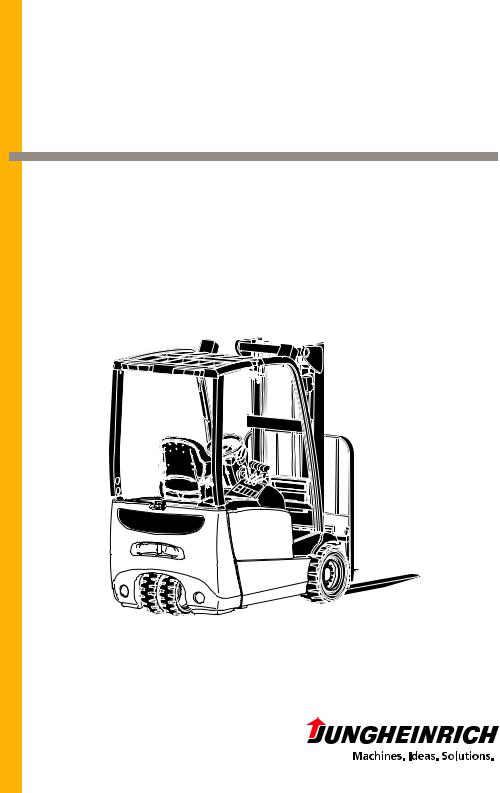
EFG 216kn
Operating Instructions
51159405 04.09
04.09- G
Foreword
The present ORIGINAL OPERATING INSTRUCTIONS are designed to provide sufficient instruction for the safe operation of the industrial truck. The information is provided clearly and concisely. The chapters are arranged by letter. Each chapter starts with page 1. The page identification consists of a chapter letter and a page number.
For example: Page B 2 is the second page in chapter B.
The operating instructions detail different truck models. When operating and servicing the truck, make sure that the instructions apply to your truck model.
Safety instructions and important explanations are indicated by the following graphics:
FUsed before safety instructions which must be observed to avoid danger to personnel.
MUsed before notices which must be observed to avoid material damage.
ZUsed before notices and explanations.
tUsed to indicate standard equipment.
oUsed to indicate optional equipment.
Our trucks are subject to ongoing development. Jungheinrich reserves the right to alter the design, equipment and technical features of the truck. No guarantee of particular features of the truck should therefore be inferred from the present operating instructions.
Copyright
Copyright of these operating instructions remains with JUNGHEINRICH AG.
Jungheinrich Aktiengesellschaft
Am Stadtrand 35
22047 Hamburg - GERMANY Telephone: +49 (0) 40/6948-0 www.jungheinrich.com
0108.GB
0108.GB
Table of contents
ACorrect Use and Application
BTruck Description
1 |
Application ........................................................................................... |
B |
1 |
2 |
Assemblies and Functional Description .............................................. |
B |
2 |
2.1 |
Truck ................................................................................................... |
B |
3 |
3 |
Standard Version Specifications ......................................................... |
B |
4 |
3.1 |
Dimensions ......................................................................................... |
B |
4 |
3.2 |
Mast versions ...................................................................................... |
B 6 |
|
3.3 |
Performance data ............................................................................... |
B |
6 |
3.4 |
Weights (all measurements in kg) ....................................................... |
B |
7 |
3.5 |
Tyre type ............................................................................................. |
B 7 |
|
3.6 |
EN norms ............................................................................................ |
B 8 |
|
3.7 |
Conditions of use ................................................................................ |
B |
8 |
4 |
Identification points and data plates .................................................... |
B |
9 |
4.1 |
Truck data plate .................................................................................. |
B |
10 |
4.2 |
Truck load chart .................................................................................. |
B |
11 |
4.3 |
Fork load chart (basic model) .............................................................. |
B 11 |
|
4.4 |
Attachment load chart ......................................................................... |
B |
12 |
C |
Transport and Commissioning |
|
|
1 |
Lifting by crane .................................................................................... |
C |
1 |
2 |
Securing the truck during transport ..................................................... |
C |
2 |
3 |
Using the truck for the first time .......................................................... |
C |
3 |
4 |
Operating the Truck without its own Drive System ............................. |
C |
4 |
D |
Battery - Servicing, Recharging, Replacement |
|
|
1 |
Safety Regulations Governing the Handling of Lead-Acid |
|
|
|
Batteries .............................................................................................. |
D |
1 |
2 |
Battery types ....................................................................................... |
D |
2 |
3 |
Exposing the battery ........................................................................... |
D |
3 |
4 |
Charging the battery ............................................................................ |
D |
4 |
5 |
Battery removal and installation .......................................................... |
D |
5 |
6 |
Closing the battery cover .................................................................... |
D |
6 |
7 |
Battery Discharge Indicator, Battery Discharge Monitor, |
|
|
|
Hourmeter ........................................................................................... |
D |
6 |
0409.GB
I 1
E |
Operation |
|
1 |
Safety regulations for the operation of forklift trucks ........................... |
E 1 |
2 |
Controls and Displays ......................................................................... |
E 2 |
2.1 |
Instrument panel switches ................................................................... |
E 4 |
2.2 |
Control panel switches ........................................................................ |
E 4 |
2.3 |
Multitask display .................................................................................. |
E 5 |
2.4 |
Warning displays, buttons and switches ............................................. |
E 6 |
2.5 |
Displays ............................................................................................... |
E 7 |
2.6 |
Setting the time ................................................................................... |
E 7 |
2.7 |
Driver’s Display Warning Messages ................................................... |
E 8 |
3 |
Starting up the Truck ........................................................................... |
E 9 |
3.1Checks and operations to be performed before starting
|
daily operation ..................................................................................... |
E 9 |
3.2 |
Trucks with reduced headroom X (o) ................................................. |
E 9 |
3.3 |
Driver's seat ........................................................................................ |
E 10 |
3.4 |
Adjusting the steering column ............................................................. |
E 12 |
3.5 |
Preparing the truck for operation ......................................................... |
E 12 |
3.6 |
Safety restraint belt ............................................................................. |
E 13 |
4 |
Industrial Truck Operation ................................................................... |
E 15 |
4.1 |
Safety regulations for truck operation ................................................. |
E 15 |
4.2 |
Travel .................................................................................................. |
E 16 |
4.3 |
Steering ............................................................................................... |
E 17 |
4.4 |
Braking ................................................................................................ |
E 18 |
4.5 |
Operating the lift mechanism and attachments (SOLO-PILOT) .......... |
E 19 |
4.6 |
Lifting, transporting and depositing loads ............................................ |
E 21 |
4.7 |
Parking the truck securely ................................................................... |
E 24 |
4.8 |
Towing trailers ..................................................................................... |
E 25 |
5 |
Troubleshooting .................................................................................. |
E 26 |
5.1 |
Temperature control ............................................................................ |
E 26 |
F |
Industrial Truck Maintenance |
|
1 |
Operational Safety and Environmental Protection ............................... |
F 1 |
2 |
Maintenance Safety Regulations ......................................................... |
F 1 |
3 |
Servicing and Inspection ...................................................................... |
F 3 |
4 |
EFG216kn Maintenance Checklist ....................................................... |
F 4 |
5 |
EFG 216kn lubrication chart ................................................................. |
F 6 |
5.1 |
Consumables ....................................................................................... |
F 7 |
6 |
Maintenance Instructions ..................................................................... |
F 8 |
6.1 |
Preparing the truck for maintenance and repairs ................................. |
F 8 |
6.2 |
Opening the rear panel ........................................................................ |
F 8 |
6.3 |
Checking the wheel attachments. ........................................................ |
F 8 |
6.4 |
Rear wheel rated condition .................................................................. |
F 8 |
6.5 |
Checking the hydraulic oil level ............................................................ |
F 9 |
0409.GB
I 2
6.6 |
Checking the gear oil level ................................................................... |
F 10 |
6.7 |
Draining the oil ..................................................................................... |
F 10 |
6.8 |
Adding oil ............................................................................................. |
F 10 |
6.9 |
Replacing the hydraulic oil filter ........................................................... |
F 10 |
6.10 |
Checking the brake fluid level .............................................................. |
F 11 |
6.11 |
Seat belt maintenance ......................................................................... |
F 11 |
6.12 |
Checking electrical fuses ..................................................................... |
F 12 |
6.13 |
Recommissioning ................................................................................. |
F 13 |
7 |
Decommissioning the industrial truck ................................................... |
F 13 |
7.1 |
Prior to decommissioning: .................................................................... |
F 13 |
7.2 |
During decommissioning: ..................................................................... |
F 13 |
7.3 |
Returning the truck to operation after decommissioning ...................... |
F 14 |
8 |
Safety tests to be performed at intervals and |
|
|
after unusual incidents ......................................................................... |
F 14 |
9 |
Final de-commissioning, disposal ........................................................ |
F 14 |
0409.GB
I 3
0409.GB
I 4
Appendix
JH Traction Battery Operating Instructions
ZThese operating instructions apply only to Jungheinrich battery models. If using another brand, refer to the manufacturer's operating instructions.
MIf using a battery with closed EPzV and EPzV ironclad plates, this must first be discussed with the manufacturer.
0506.GB
1
2
0506.GB
A Correct Use and Application
ZThe “Guidelines for the Correct Use and Application of Industrial Trucks” (VDMA) are supplied with the truck. The guidelines form part of these operating instructions and must be observed. National regulations apply in full.
The truck described in the present operating instructions is an industrial truck designed for lifting and transporting loads.
It must be used, operated and serviced in accordance with the present instructions. All other types of use lie beyond the scope of application and can result in damage to
personnel, the truck or property. In particular, avoid overloading the truck with loads which are too heavy or placed on one side. The data plate attached to the truck and the load diagram are binding with regard to the maximum load capacity. The owner must ensure that any damaged and/or illegible load diagrams are replaced. The industrial truck must not be used in fire or explosion endangered areas, or areas threatened by corrosion or excessive dust.
Proprietor responsibilities: For the purposes of the present operator manual the “proprietor” is defined as any natural or legal person who either uses the industrial truck himself, or on whose behalf it is used. In special cases (e.g. leasing or renting) the proprietor is considered the person who, in accordance with existing contractual agreements between the owner and user of the industrial truck, is charged with operational duties.
The proprietor must ensure that the truck is only used for the purpose it is designed for and that any danger to life and limb of the user and third parties is avoided. Furthermore, accident prevention regulations, safety regulations and operating, servicing and repair guidelines must be followed. The proprietor must ensure that all truck users have read and understood this operator manual.
MFailure to comply with the operating instructions shall invalidate the warranty. The same applies if improper work is carried out on the truck by the customer or third parties without the permission of the manufacturer’s customer service department.
Attaching accessories: The mounting or installation of additional equipment which affects or enhances the performance of the industrial truck requires the written permission of the manufacturer. In some cases, local authority approval shall be required.
Approval of the local authorities however does not constitute the manufacturer’s approval.
Trailing and towed loads: The truck may only be used for trailing or towed loads for which the truck has been approved.
0504.GB
A 1
0504.GB
A 2
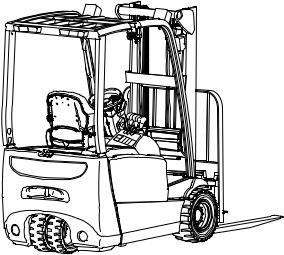
B Truck Description
1Application
The EFG is a three-wheel electric sit-down counterbalanced truck. It is cantilevered and the load handler mounted on the front of the truck can unload lorries without hindrance and deposit the load on ramps or in racks. Closed bottom pallets can also be lifted.
Truck models and maximum capacity:
Type |
Max. capacity *) |
Load centre of gravity |
EFG 216kn |
1,600 kg |
500 mm |
*) The load charts attached to the truck are binding in terms of capacity
0209.GB
B 1
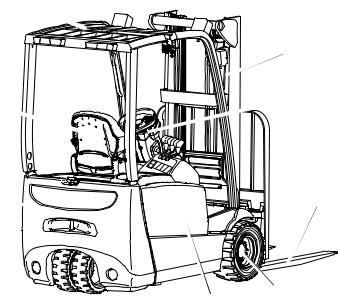
2 Assemblies and Functional Description
1
 8
8
2 |
7 |
|
3 |
6 |
 5
5
4
Item |
|
Description |
1 |
t |
Overhead guard |
2 |
t |
Driver's seat |
3 |
t |
Counterweight |
4 |
t |
Battery behind panel |
5 |
t |
Power |
6 |
t |
Load handler |
7 |
t |
Steering system |
8 |
t |
Mast |
0209.GB
B 2
2.1Truck
Steering (7): A low steer effort of 15 N as well as a favourable transmission ratio of 5 steering wheel revolutions ensure fast and comfortable steering. The hydraulic rack and pinion steering keeps wear parts down to a minimum, bringing the advantage of a compact steer unit. The standard twin tyres reduce the steer effort and increase the useful life of the wheels.
Driver’s seat (2): The driver's seat is the centre point of any lift truck. Our trucks are particularly strong in this respect. They feature a comfort seat with an adjustable steering column as well as storage facilities for papers or the driver's personal belongings.
Electrical/Electronic System: The latest AC threephase system using a CAN Bus system to minimise the number of cable leads. This results in less downtime due to cable breakage and considerably faster troubleshooting. The advanced controller is simple, safe and flexible. The driver can choose from five travel programs, depending on the load and the environment: from maximum performance to energy saving. Error analysis and programming can be performed simply and above all rapidly by PC.
Drive System and Brakes: The 2-motor front drive provides maximum traction to the drive wheels at all times. Each motor receives the exact power it requires in proportion to the steering angle. The wheels do not spin and there is no loss of energy.
The hydraulic oil bath multi-plate brakes form the operating brake and are practically maintenance-free. The gear encapsulation allows the truck to be used even in hostile environments. The truck also brakes to a halt regeneratively via the traction motors. This minimizes energy consumption. Even on ramps the truck will not simply roll away.
Hydraulic System: All operations can be performed sensitively, proportionally and simultaneously (insofar as they do not affect safety). To ensure greater efficiency, a hydraulic unit and steering booster motor operate independently of each other. The micro pressure filter can be replaced from the top (without spilling hydraulic oil).
Mast (8): The aim is to optimise visibility. The cold rolled maximum strength steel sections are extremely narrow, allowing for good fork visibility in particular with the three-stage mast. The same standard has been achieved for the fork carriage.
The lift rails and the fork carriage run on permanently-lubricated and hence maintenance-free angled rollers.
0209.GB
B 3
3 Standard Version Specifications
3.1Dimensions
|
Description |
EFG 216kn |
|
h1 |
Mast height retracted |
2000 |
mm |
h2 |
Free lift |
150 |
mm |
h3 |
Lift |
3000 |
mm |
h4 |
Mast height extended |
4220 |
mm |
h6 |
Overhead guard height |
1960 |
mm |
h7 |
Seat height |
890 |
mm |
h10 |
Hitch height |
560 |
mm |
L1 |
Length including forks |
3049 |
mm |
L |
Headlength 1) |
1899 |
mm |
2 |
|
|
|
b1 |
Overall width |
1060 |
mm |
e |
Fork width |
100 |
mm |
m1 |
Ground clearance with load below mast |
80 |
mm |
m2 |
Centre wheel base ground clearance |
90 |
mm |
Ast |
Working aisle width |
3348 |
mm |
for pallets 800 x 1200 longit. |
|||
Ast |
Working aisle width |
3224 |
mm |
for pallets 1000 x 1200 traverse |
|||
Wa |
Turning radius |
1545 |
mm |
x |
Load distance 1) |
352 |
mm |
y |
Wheelbase |
1357 |
mm |
1) = +25 mm DZ mast
0209.GB
B 4
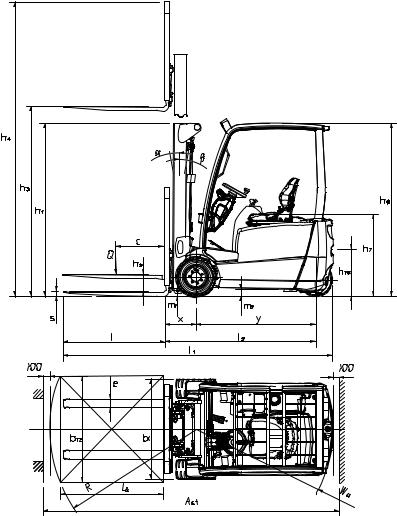
0209.GB
B 5

3.2Mast versions
(all dimensions in mm)
EFG 216kn mast chart
VDI 3596 |
Lift |
Free lift |
Height |
Height |
|
|
|
|
retr. |
extd. |
|
Description |
h3 |
h2 |
h1 |
h4 |
|
|
|
EFG216kn |
|
EFG 216kn |
|
|
3000 |
150 |
2000 |
4220 |
|
|
3300 |
150 |
2150 |
4520 |
|
ZT |
3600 |
150 |
2300 |
4820 |
|
4000 |
150 |
2500 |
5220 |
||
|
|||||
|
4500 |
150 |
2800 |
5720 |
|
|
5000 |
150 |
3050 |
6220 |
|
|
3300 |
1545 |
2105 |
4520 |
|
ZZ |
3600 |
1695 |
2255 |
4820 |
|
|
4000 |
1895 |
2455 |
5220 |
|
|
4500 |
1445 |
2005 |
5720 |
|
|
4800 |
1545 |
2105 |
6020 |
|
DZ |
5000 |
1620 |
2180 |
6220 |
|
|
5500 |
1795 |
2355 |
6720 |
|
|
6000 |
1995 |
2555 |
7220 |
3.3Performance data
|
Description |
EFG 216kn |
|
Q |
Capacity |
1600 |
kg |
|
(where C = 500 mm) *) |
||
|
|
|
|
C |
Load centre |
500 |
mm |
|
Travel speed w / w.o. load |
16/16 |
km/h |
|
Lift speed (lift) w / w.o. load |
0.38/0.59 |
m/s |
|
Lift speed (lower) w / w.o. load |
0.55/0.55 |
m/s |
|
Gradeability (30 min) |
7.3/12.3 |
% |
|
with / without load |
||
|
|
|
|
|
Max. gradeability (5 min) |
20.0/35.0 |
% |
|
with / without load |
||
|
|
|
|
|
Acceleration (10 m) |
3.8/3.4 |
s |
|
w / w.o. load |
||
|
|
|
*) with vertical mast
0209.GB
B 6
3.4Weights (all measurements in kg)
Description |
EFG 216kn |
|
Truck weight |
2990 |
|
(including battery) |
||
|
||
Front axle load (without lifting load) |
1410 |
|
Front axle load (with lifting load) |
4015 |
|
Rear axle load (without lifting load) |
1580 |
|
Rear axle load (with lifting load) |
575 |
3.5Tyre type
Description |
|
EFG 216kn |
|
|
|
Tyre size, front |
SE |
18 x 7 -8, 16PR |
|
|
|
Tyre size, rear |
SE |
140 / 55 - 9 |
|
|
|
ZPermissible tyres: See chapter F “Forklift Truck Maintenance”. If you have any queries please contact your Jungheinrich customer adviser.
0209.GB
B 7
3.6 EN norms |
|
Noise emission: |
66 dB(A) |
|
in accordance with EN 12053 as harmonised with |
|
ISO 4871. |
ZThe noise emission level is calculated in accordance with standard procedures and takes into account the noise level when travelling, lifting and when idle. The noise level is measured at the level of the driver's ear.
Vibration (measured with the MSG 65 driver's seat (o)): 0.79 m/s2
in accordance with EN 13059.
ZThe vibration acceleration acting on the body in the operating position is, in accordance with standard procedures, the linearly integrated, weighted acceleration in the vertical direction. It is calculated when travelling over bumps at constant speed.
Electromagnetic compatibility (EMC)
The manufacturer confirms that equipment complies with tolerance levels for electromagnetic emissions and resistance as well as static electricity discharge testing in accordance with EN 12895 including the normative procedures contained therein.
ZNo changes to electric or electronic components or their arrangement may be made without the written agreement of the manufacturer.
3.7Conditions of use
Ambient temperature
- operating at -20 qC to 40 qC
ZSpecial equipment and authorisation are required if the truck is to be constantly used in conditions of extreme temperature or air humidity fluctuations.
0209.GB
B 8
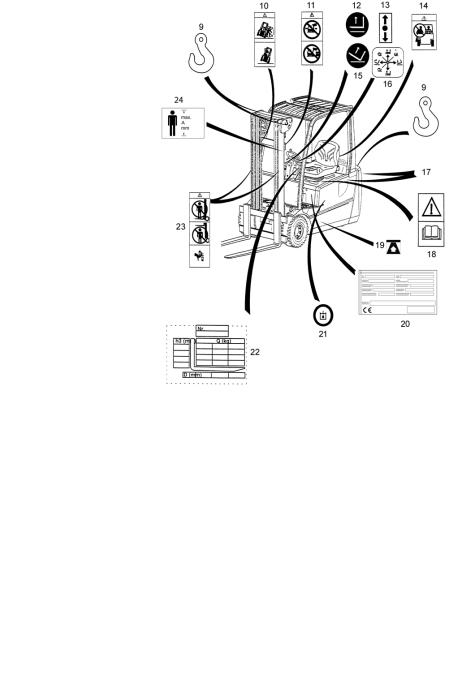
4 Identification points and data plates
FWarnings and notices such as load charts, strap points and data plates must be legible at all times. Replace if necessary.
|
Item |
Description |
|
|
9 |
Strap points |
|
|
10 |
Risk of crashing notice |
|
|
11 |
Decal: Travelling with raised load, mast forward tilt with raised load forbidden |
|
|
12 |
Lift notice |
|
|
13 |
Forward / reverse notice |
|
|
14 |
“No passengers” notice |
|
|
15 |
Lower notice |
|
|
16 |
Hydraulic function (Multi-Pilot) notice |
|
|
17 |
Max. speed notice |
|
|
18 |
Read operating instructions notice |
|
|
19 |
Jack contact points |
|
|
20 |
Data plate |
|
|
21 |
Add hydraulic oil notice |
|
|
22 |
Capacity decal |
|
0209.GB |
23 |
Do not step onto or beneath the load, trap point |
|
24 |
Maximum body size notice |
||
|
B 9
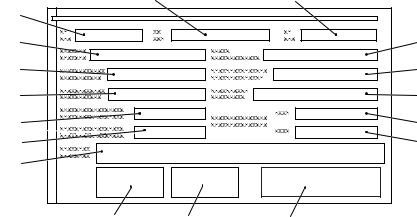
4.1Truck data plate
25 |
41 |
40 |
|
|
|
26 |
|
39 |
27 |
|
38 |
28 |
|
37 |
29 |
|
36 |
30 |
|
35 |
31 |
|
|
32 |
33 |
34 |
Item |
Description |
Item |
Description |
25 |
Type |
34 |
Manufacturer’s logo |
26 |
Name |
35 |
Max. battery weight in kg |
27 |
Battery: Voltage (V) |
36 |
Min. battery weight in kg |
28 |
Rated capacity (kg) |
37 |
Output (kW) |
29 |
Net weight w.o. battery (kg) |
38 |
Load centre (mm) |
30 |
Net weight with battery (kg) |
39 |
Year of manufacture |
31 |
Manufacturer |
40 |
Serial No. |
32 |
Production |
41 |
Option |
33 |
Production address |
|
|
ZFor queries regarding the truck or ordering spare parts always quote the truck serial number (26).
0209.GB
B 10
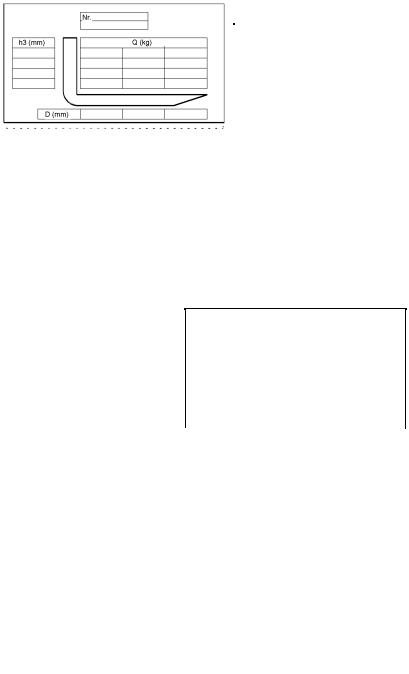
4.2Truck load chart
The load chart (22) gives the capacity (Q) of the truck in kg with a vertical mast. The maximum capacity is shown as a table with a given load centre of gravity D (in mm) and the required lift height H (in mm).
Example:
22
4250 |
850 |
850 |
600 |
|
1105 |
1105 |
850 |
||
3600 |
||||
1250 |
1250 |
850 |
||
2900 |
||||
|
|
|
||
|
500 |
600 |
700 |
Example of how to calculate the maximum capacity:
With a load centre of gravity D of 600 mm and a maximum lift height H of 3600 mm. the max. capacity Q is 1105 kg.
4.3Fork load chart (basic model)
The fork load chart give the truck’s capacity Q in kg. The maximum capacity for the various load centres of gravity (D in mm) is shown in the form of a chart.
0209.GB
B 11
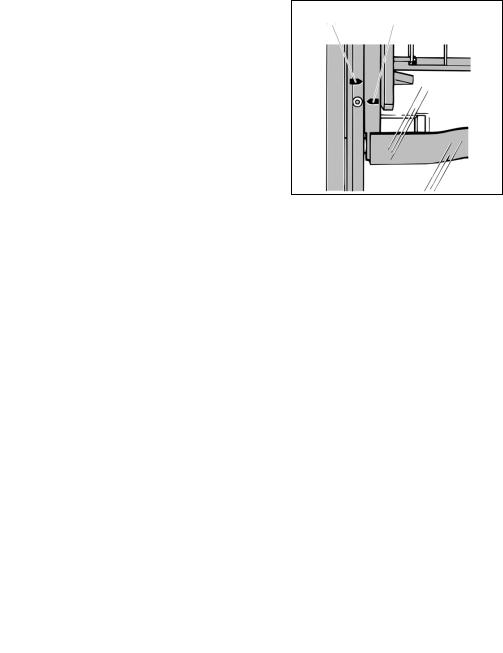
4.4Attachment load chart
The attachment load chart gives the truck capacity Q in conjunction with the respective attachment in kg. The serial number specified in the load chart must match the data plate of the attachment, as the capacity for each truck is specifically indicated by the manufacturer. It is shown in the same way as the truck capacity and can be determined accordingly.
The arrow shape markings (37 and 38)
on the inner and outer masts show the 37 38 driver when the prescribed lift limits have
been reached.
0209.GB
B 12

C |
Transport and Commissioning |
||
1 |
Lifting by crane |
|
|
M |
Only use lifting gear with sufficient |
|
|
1 |
|||
capacity |
|||
|
(transport weight = net. weight + battery |
|
|
|
weight, see truck data plate). |
|
|
– Parking the truck securely (see Chapter E).
–Attach the crane slings to the cross member of the mast (1) and the trailer coupling (2).
M |
The crane lifting gear couplings must be |
|
|
||
fitted in such a way that they do not |
|
|
|
touch any attachments or the overhead |
|
|
guard during lifting. |
2 |
|
|
0409.GB
C 1
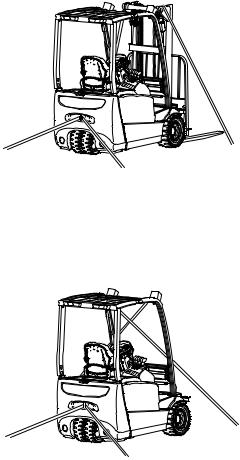
2 Securing the truck during transport
MThe truck must be securely fastened when transported on a lorry or a trailer. The lorry / trailer must have fastening rings. Loading must be carried out by specially trained staff in accordance with recommendations contained in Guidelines VDI 2700 and VDI 2703. In each case correct measurements must be made and appropriate safety measures adopted.
ZTo secure the truck with the mast assembled, use the eyes on the upper cross member of the mast and the trailer pins.
Securing the truck with an installed mast
ZIf the truck is to be transported without a mast, it must be tied down at the front over the overhead guard.
Securing the truck without a mast
0409.GB
C 2
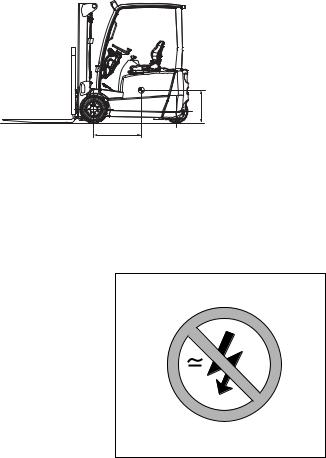
z |
y |
Approximate centre of gravity position
3 |
Using the truck for the first time |
F |
Commissioning and driver instruction must be performed by trained personnel. |
If several trucks are supplied, make sure that only load pickup devices, masts and |
|
|
basic trucks with the same serial number are assembled. |
MOnly operate the truck with battery current. Rectified AC current will damage the electronic components. The battery leads (tow cables) must be less than 6m long.
To prepare the truck after delivery or after transport, proceed as follows:
–Check the equipment is complete.
–Test the battery connections.
–Start up the truck as indicated. (see Chapter E).
0409.GB
C 3
4Operating the Truck without its own Drive System
If the truck needs to be towed, proceed as follows:
–Attach the tow bar / rope to the trailer coupling of the recovery vehicle and the truck to be recovered.
–Disconnect the battery (see chapter D).
–Release the parking brake.
FOnespeed.person must be seated in the towed truck to steer it. Tow the truck at walking
ZAs the power steering system is not switched on, extra effort is required to steer the truck.
0409.GB
C 4
D Battery - Servicing, Recharging,
Replacement
1Safety Regulations Governing the Handling of Lead-Acid Batteries
Park the truck securely before carrying out any work on the batteries (see Chapter E).
Maintenance personnel: Recharging, servicing and replacing of batteries must only be performed by qualified personnel. This operator manual and the manufacturer’s instructions concerning batteries and charging stations must be observed when carrying out the work.
Fire protection: Smoking and open flames are not permitted when handling batteries. Wherever a truck is parked for charging there shall be no inflammable material or consumables capable of creating sparks within a 2-meter area of the truck. The room must be ventilated. Fire protection equipment must be on hand.
Battery maintenance: The battery cell covers must be kept dry and clean. Terminals and cable shoes must be clean, lightly greased with terminal grease and must be securely tightened. Batteries with non insulated terminals must be covered with a non slip insulating mat.
Battery disposal: Batteries may only be disposed of in accordance with national environmental protection regulations or disposal laws. The manufacturer’s disposal instructions must be followed.
MBefore closing the battery panel make sure that the battery lead cannot be damaged.
FBatteries contain dissolved acid which is toxic and caustic. For this reason protective clothing and goggles must be worn whenever work is undertaken on batteries. Avoid physical contact with battery acid.
Nevertheless, should clothing, skin or eyes come in contact with acid the affected parts should be rinsed with plenty of clean water - where the skin or eyes are affected call a doctor immediately. Neutralise any spilled battery acid immediately.
MOnly batteries with a sealed battery container may be used.
FThe weight and dimensions of the battery have considerable affect on the operational safety of the truck. Battery equipment may only be replaced with the agreement of the manufacturer.
0409.GB
D 1
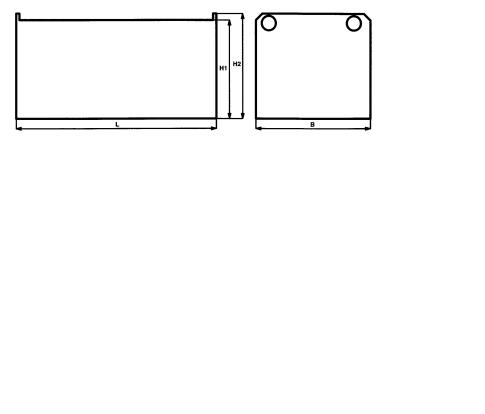
2Battery types
The truck will be equipped with different battery types, depending on the application. The following table shows which combinations can be included as standard with reference to capacity:
EFG 216kn |
48 V - 5PzS - 600 Ah battery |
The battery weights are indicated on the battery data plate.
FWhen replacing/installing the battery make sure the battery is securely located in the battery compartment of the truck.
FThe weight and size of the battery have a considerable affect on the operational safety of the truck. The size and weight of the batteries must therefore comply with the following table and diagram. The use of different batteries on the truck requires the manufacturer’s authorisation.
|
|
48 volt drive battery |
|
|
similar to |
||
|
|
|
|
DIN 43535 |
|||
|
|
|
|
|
|
|
|
|
|
|
|
|
|
||
Truck |
|
Dimension inch (mm) |
|
Rated weight |
|
||
L max. |
W max. |
H1 |
|
H2 |
(-5/+8%) in kg |
|
|
|
+/- 2 mm |
|
+/- 2 mm |
|
|||
|
|
|
|
|
|
||
|
|
|
|
|
|
|
|
EFG 216kn |
830 |
630 |
612 |
|
627 |
856 |
500 - 630 Ah |
|
|
|
|
|
|
|
|
|
|
|
|
|
|
|
|
0409.GB
D 2
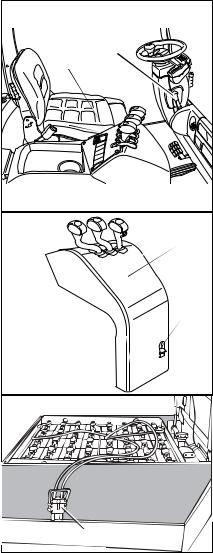
3 Exposing the battery
FPark the truck securely (see chapter E).
–Release the steering column lock (1), push the steering column forward and secure it in this position.
FPay extra attention when unlocking and locking the pilot valve cover.
–Press the lever (4) to unlock the pilot valve cover (2) and move it forward.
–Carefully lift back the battery panel (3) with the driver’s seat.
–Remove the battery connector (5).
–Where necessary remove the insulating mat from the battery.
FThe battery plug and socket may only withdrawn or connected when the main switch and the charging equipment are switched off.
0409.GB
1 |
3 |
2 |
4 |
5 |
D 3 |
